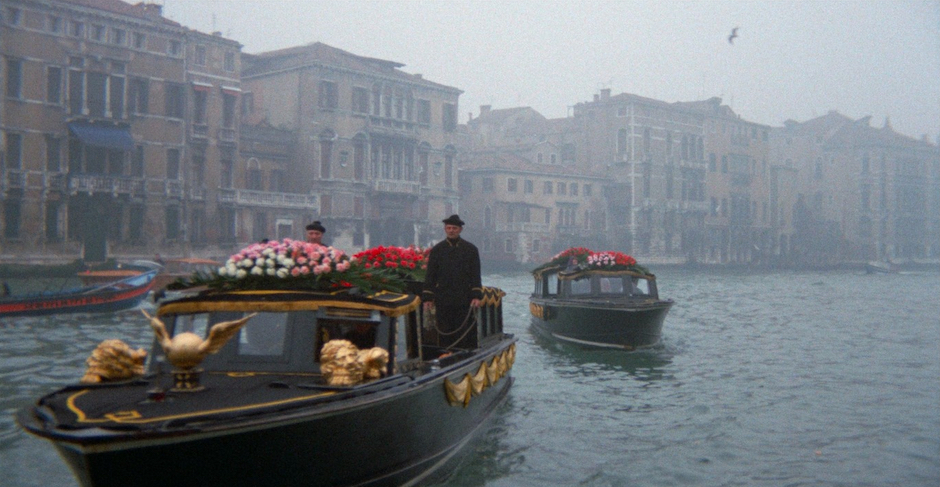Thomas Mann takes us to the strange beauty of a misty Venice and the devastation brought on by a cholera epidemic in 1911.
 The supernatural elements of the film “Don’t look now” turn death into a foretold reality.
The supernatural elements of the film “Don’t look now” turn death into a foretold reality.
That which is not in our power to change produces boundless fear. One day we seem to be in control of our lives and the next we realize that we have nothing.
Thomas Mann takes us to the strange beauty of a misty Venice and the devastation brought on by a cholera epidemic in 1911.
It is impossible to think of Visconti’s film without hearing the adagietto of Mahler’s Fifth Symphony. The figure of Aschenbach, the character played by Dirk Bogarde in “Death in Venice”, lies on the Lido beach, as the figure of his adored Tadzio appears in the water with his hand outstretched.
Venice is a beautiful city, but it produces a strange feeling of melancholy, often associated with death. I visited the city for the first time after a conference of European Evangelical theologians.
I was with a professor Church History from Dublin and the well-known Calvinist specialist of the London School of Theology, Tony Lane.
The wind made the gondolas moored at the now deserted St Mark’s wharf bob up and down, as the city got ready to throw off its winter garb and receive the thousands of tourists that arrive during the summer season.
Under a cloudy sky, a vaporetto took us to San Michele island, where you can visit the tombs of all the artists buried there. It is the final resting place of musicians Wagner and Stravinsky, the poets Pound and Brodsky, and the dancer Diaghilev.
In Visconti’s film, the sick writer in Mann’s novel becomes a musician who remembers Mahler. His agonized life revolves around a conflict between reason and passion, with a troubling beauty that captivates us.
It tells of the grief of a pathetic man, tormented by pain and dominated by failure. In a terrifying scene, a barber recreates the face of Aschenbach in a grotesque parody of youth, becoming an ominous death mask.

During our visit, the Biennale was putting on an exhibition of the particular vision of the Pietà by Michelangelo by the Belgian artist, Jan Fabre. It replaced Mary’s face with a skull and Jesus with the image of the sculptor himself – he has been in a coma on two occasions.
Upon entering the exhibition, visitors were required to change into slippers to keep the silence required by the artist unbroken. Once inside, four huge brains with protruding crosses representing different beliefs led the way to the cadaverous Pietà.
Butterfly chrysalids surrounded the sculpture, all made out of Carrara marble “from the same quarries used by Michelangelo” explains Fabre. “As white as breast milk”. His interpretation of this religious image, he claims, does not seek to provoke or hurt anyone.
He follows the Flemish tradition, which he combines with that of Italian art, to state the “memento mori, the unescapable mortality of humanity”.
This sculptor believes that “we live in a society in which we have to be young, dynamic and productive, but death lies at the antipodes of this project of existence”.
It is something that is hidden because “it is not good for business”. Given that, according to him, “we are not going through an economic crisis, but a spiritual one”.

Fabre was born in Antwerp in 1958. He remembers his grandmother dying when he was little. The wake lasted for a whole week and the body was kept in a room to which friends from far and wide came to say their last farewell to her.
Having himself been in a state of coma on two occasions – once for nine days and then again for five – Fabre says that “the idea of death is always near at hand…it makes you see life differently”. In the exhibition he wanted “the spectator to open his mind and to think a bit about the lack of spirituality in today’s society”.
As I tend to do whenever I am on a trip, I spend my evenings watching the films shot in the city that I am visiting. I am particularly impressed by the film by Nicolas Roeg, “Don’t look now” (1973).
It provides a powerful portrayal of the breakdown of the marriage of the couple in the story written by Daphne du Maurier – the author of Rebeca and The birds – who have lost their daughter, and are trying to get their lives back on track in labyrinthine Venice.
The dark and wintery setting of the film – starring Donald Sutherland and Julie Christie – creates an overwhelming feeling of tension, which I try to relive by walking along the streets where it was shot.
The death of their daughter from meningitis in the original story becomes an awful accident in the film, in which the girl drowns while playing. Water and falling become a leitmotif in this impressionist film, where the fragmentation of the sets and erroneous identifications produce the confusion that becomes part of life and the passing of time.
The supernatural elements of this story turn death into a foretold reality. The mysterious character of the bishop who has ordered the restauration of the church that I visited, is as unsettling as the blind old lady who says that she sees their daughter and warns the father of an imminent danger.
When the bishop asks the wife whether she is a believer, she answers that she does not know. The bishop then cryptically says “we have stopped listening to God”. What remains, however, is the tragedy of the pain of an unexpected loss, since the death foretold is never our own.

“No one told me that grief was so like fear”, C.S. Lewis wrote at the beginning of A grief observed. The reflections of this well-known Christian thinker following the death of his wife continue to be one of the most honest testimonials of the perplexity of grief.
He also noted that, “[p]art of every misery is, so to speak, the misery’s shadow or reflection: the fact that you don’t merely suffer but have to keep on thinking about the fact that you suffer”.
“Jesus was a very compassionate man”, says Fabre. He provides a “model of compassion and empathy” for the artist. His piety, however, “brings to the fore the true feelings of a mother who would like to substitute herself for her dead son”.
Where is God in the midst of the confusion and bereavement? Lewis replies that people “need Christ, not something that resembles Him”.
Christ broke down at the loss of his friend Lazarus. “Jesus wept” (John 11:35), says the shortest verse of the Bible. Those who saw Jesus’ bereavement said “See how he loved him!” (V. 36).
Some asked themselves whether he couldn’t have done something to prevent Lazarus’ death (v. 37), but Jesus was “deeply moved” (v. 38). Christ reveals to us a God of compassion.
Fabre says that Jesus provides the first body in the history of art. The Christian hope is tremendously physical. There is no other image like that of Christ for life after death: “I am the resurrection and the life. The one who believes in me will live, even though they die; and whoever lives by believing in me will never die” (John 11:25–26).
It is He “who has destroyed death and has brought life and immortality to light through the gospel” (2 Timothy 1:10).
His resurrection isn’t a spiritual rebirth, but a return to life in the physical sense. Our hope isn’t in the message of the resurrection but in the fact that his body rose from the dead.
For this reason, when faced with pain and confusion, we can say with Job “I know that my redeemer lives, and that in the end he will stand on the earth. And after my skin has been destroyed, yet in my flesh I shall see God” (19: 25–26).
We sometimes feel a strange ambivalence when faced with death. It leaves us perplexed because we desire immortality and life. We have a vocation of permanence.
On the other hand, however, we desire death as an end point to our existence. We feel failure and experience a detachment with life that comes from our awareness that we are not prepared for eternity.
Our hope does not, however, lie in our good life, but in the confession of Martha at the question of Jesus “do you believe this?”. She answers: “Yes, Lord … I believe that you are the Messiah, the Son of God, who is to come into the world.” (John 11:27).
He has come to seek and save that which was lost. In his mercy “He will wipe every tear from their eyes. There will be no more death or mourning or crying or pain.” (Revelation 21:4). He is the life that we need.
[donate]

Las opiniones vertidas por nuestros colaboradores se realizan a nivel personal, pudiendo coincidir o no con la postura de la dirección de Protestante Digital.
Si quieres comentar o